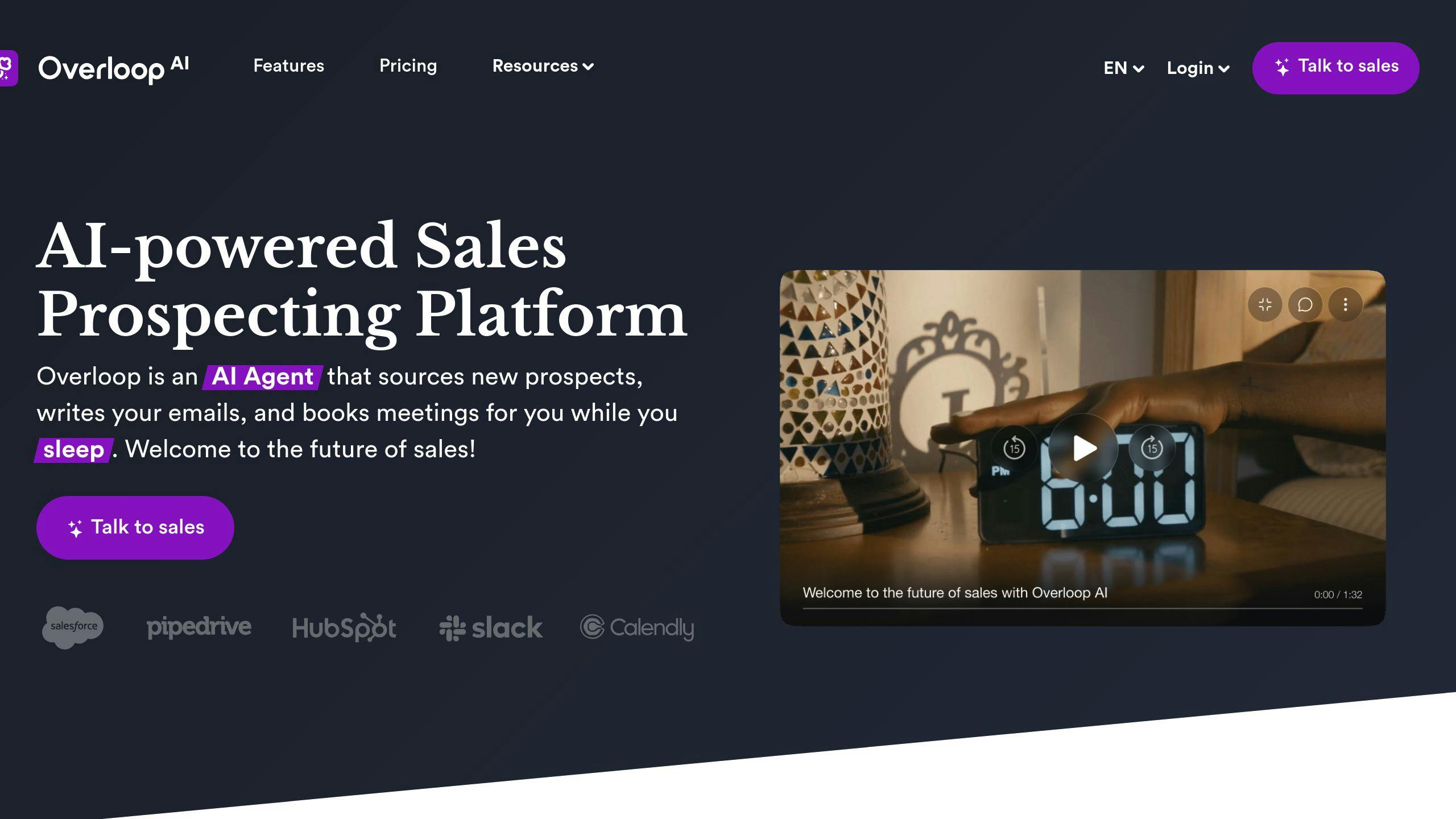Scalable lead generation workflows help businesses handle more leads efficiently, improve lead quality, and save time using automation and templates. Here's how you can create one:
- Automation Tools: Use tools like Overloop AI to streamline lead sourcing, email personalization, and multi-channel outreach.
- Customizable Templates: Maintain consistent messaging while tailoring campaigns for different audiences.
- Lead Nurturing Strategies: Combine automation with personalized follow-ups to engage prospects effectively.
Key Benefits:
- Save time by automating repetitive tasks.
- Improve lead quality with AI-driven insights.
- Ensure consistent communication across platforms.
By integrating tools with your CRM and analyzing performance regularly, you can optimize workflows for long-term growth. Start by defining clear goals, choosing the right tools, and monitoring results to refine your process.
11 Make.com Automations You Need to Start Using Every Day
Key Elements of Scalable Lead Generation Workflows
To build workflows that can grow with your business, focus on three main components: automation tools, customizable templates, and strategic lead nurturing. These elements work together to streamline processes, improve efficiency, and maintain quality as you scale.
Automation Tools to Simplify Lead Generation
Automation tools are a game-changer for handling larger volumes of leads without sacrificing quality. For example, Overloop AI integrates lead sourcing, email personalization, and multi-channel outreach into one system, allowing teams to manage more leads efficiently.
| Tool Type | Primary Function | Key Benefits |
|---|---|---|
| Lead Sourcing | Automated contact discovery and verification | Cuts down manual research by 75% |
| Email Automation | AI-generated personalized messages | Ensures consistent outreach quality |
| Multi-channel Tools | Unified campaigns across platforms | Delivers a seamless prospect experience |
Customizable Templates for Consistency and Speed
Templates are a quick way to maintain consistency while tailoring campaigns for different audiences. Platforms like involve.me and fillout.com offer flexible frameworks to match various campaign needs, saving time and effort.
"Best practices include using multi-channel approaches, leveraging automation for scalability, and integrating offline and online lead sources with a central CRM system." [2]
HubSpot takes this further with its lead scoring system, which automates the evaluation of prospects, ensuring quality remains high even as workflows expand.
Strategies to Effectively Nurture Leads
Balancing automation with personalization is key to nurturing leads at scale. Zendesk sets a great example by combining behavior tracking, multi-channel retargeting, and data-driven personalization. Their strategy includes automated follow-ups paired with educational resources like webinars, helping them guide prospects without losing the personal touch.
Key pieces of a successful nurturing strategy include:
- Tracking engagement based on behavior
- Coordinating messaging across multiple platforms
- Using data to create personalized interactions
These approaches ensure you can manage more leads while keeping the experience relevant and engaging.
Step-by-Step Process for Building Scalable Lead Generation Workflows
Step 1: Define Clear Goals for Lead Generation
Start by setting measurable goals, like "increase qualified leads by 20% in Q1 2025." Use specific metrics to track progress, such as lead volume, quality, and engagement rates. CRM dashboards and analytics tools can help you monitor these effectively.
| Goal Type | Metric | Tracking Method |
|---|---|---|
| Lead Volume | Number of new leads per month | CRM dashboard |
| Lead Quality | Lead-to-opportunity ratio | Conversion tracking |
| Engagement Rate | Email open and click rates | Email analytics |
| Response Time | Average follow-up speed | Automation metrics |
Step 2: Choose Automation Tools That Fit Your Needs
Pick tools that match your business requirements and can grow with you. Look for features like:
- Integration with your existing tech stack
- AI-powered customization for campaigns
- A database that aligns with your target audience
- Multi-channel outreach options
Step 3: Develop and Use Customizable Templates
Create templates that are easy to adjust while keeping a consistent tone and format. Dynamic content fields can help you personalize messages for large audiences. For example, tools like HubSpot allow you to build email sequences that adapt automatically based on how prospects interact with your content.
Step 4: Integrate Tools with Your CRM
Ensure that your automation tools sync seamlessly with your CRM. This makes it easier to:
- Automatically update lead data
- Track campaign results in real-time
- Keep contact information accurate across platforms
- Feed engagement metrics into your reporting system
Step 5: Analyze and Optimize Workflow Performance
Regularly evaluate performance using key metrics like conversion rates and engagement levels. Identify what works by analyzing top-performing campaigns, then apply those insights to weaker workflows. Focus on metrics such as:
- Conversion rates across channels
- Engagement levels of templates
- Campaign response rates by audience segment
- Time saved through automation
Following these steps will help you build workflows that grow with your business and handle a variety of challenges, as shown in the success stories shared below.
Examples of Successful Scalable Lead Generation Workflows
Here are some real-world examples of businesses that improved their lead generation efforts by applying scalable workflows and tools. These case studies highlight how the strategies discussed earlier can drive measurable results.
Case Study: Transforming B2B Sales with Overloop AI

A mid-sized precision tooling manufacturer revamped their lead generation process using Overloop AI's automation platform. By focusing on decision-makers in the manufacturing sector, they achieved impressive results:
| Metric | Improvement |
|---|---|
| Qualified Leads | +50% |
| Response Rate | +113% |
| Manual Task Time | -68% |
The key to their success was Overloop AI's advanced features, which included:
- Targeted outreach using Overloop's B2B database to find the right prospects in the manufacturing sector.
- Automated email campaigns triggered by engagement signals from prospects.
- Seamless integration with Salesforce and LinkedIn workflows to streamline processes.
Case Study: Integrating Automation Tools for Scalable Growth
A software services provider built a scalable lead generation system by combining multiple automation platforms. This strategic integration delivered outstanding results:
| Component | Result |
|---|---|
| Email Automation | 451% increase in qualified leads |
| Lead Scoring | 32% higher conversion rate |
| Cost Efficiency | 25% reduction in acquisition costs |
"Integrating Marketo for email workflows and HubSpot for lead scoring helped us boost qualified leads by 451% while reducing manual effort", said the company's Head of Sales Operations.
This integration allowed the team to expand their outreach while keeping messages personalized. The result? Higher conversion rates and lower acquisition costs. Their approach shows how blending the right tools can amplify lead generation efforts and drive business growth.
These examples highlight what’s possible with well-executed workflows and the right tools, offering practical insights for scaling your lead generation strategy.
Conclusion and Next Steps
The examples shared above highlight how scalable workflows can reshape business operations. Now, let’s explore how you can create your own.
Key Takeaways
Scalable workflows combine automation, templates, CRM integration, and performance tracking to boost efficiency, maintain consistency, and enable ongoing improvement. By thoughtfully integrating these components, businesses can design systems that grow seamlessly while still delivering personalized, high-quality experiences. The steps in this guide offer a clear plan to help you get started and achieve measurable outcomes.
Steps to Get Started
Here’s how to kick off your scalable lead generation workflow:
- Review Your Current Process: Take a close look at your existing lead generation approach. Identify any weak spots or inefficiencies and establish baseline metrics for comparison.
- Choose the Right Tools: Pick automation tools that fit your business needs. Platforms like Overloop AI, designed for B2B lead generation, can be a great option. Make sure these tools integrate smoothly with your CRM.
- Monitor and Refine: Keep an eye on performance metrics and tweak workflows based on data insights to improve results over time.
Keep in mind that success requires ongoing monitoring and adjustments. Start with these core steps and expand your automation efforts as you begin to see progress.
FAQs
How to automate sales prospecting?
Automating sales prospecting can simplify your process and help you handle a growing number of leads without overwhelming your team. Here's a clear guide to getting started:
1. Define Your Ideal Customer Profile (ICP)
Start by outlining the key characteristics of your perfect customer. Include details like:
- Job roles and titles
- Industry type
- Company size
- Common challenges they face
- Their buying habits
2. Choose the Right Tools
Look for tools like Overloop AI that offer strong integrations, large databases, and AI-powered personalization. These features can make your prospecting process smoother and more effective.
3. Set Up Automated Campaigns
Craft workflows that balance personalization with scalability. For example:
| Campaign Element | Best Practice | Impact |
|---|---|---|
| Email Sequences & Multi-Channel Timing | Use AI to personalize emails and optimize timing | Boosts engagement and extends reach |
4. Track and Improve
Keep an eye on key performance indicators, such as:
- Email open rates
- Conversion rates
- Lead quality scores
"Ensuring compliance with data privacy regulations like GDPR and CCPA is crucial when automating sales prospecting. Regular review and updates of privacy policies and automation processes help maintain compliance while scaling operations." [1]
While automation can save time and improve efficiency, don’t forget to add personal touches. Tailored follow-ups or direct calls help build trust and close deals. Over-relying on automation may result in generic outreach, which can hurt your chances of connecting with prospects.



